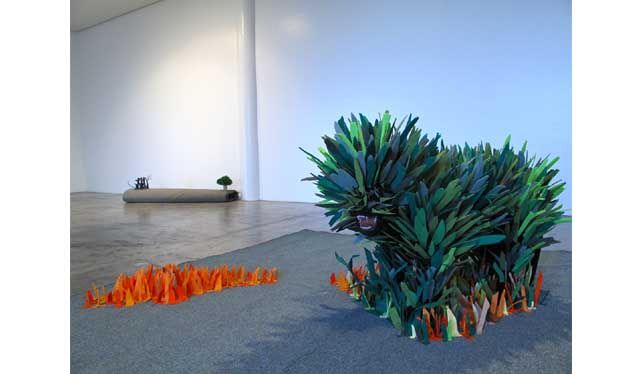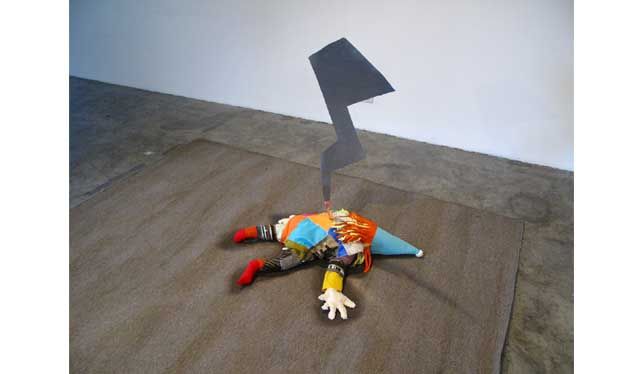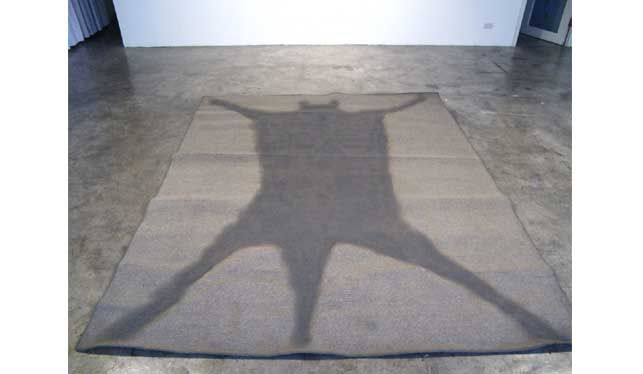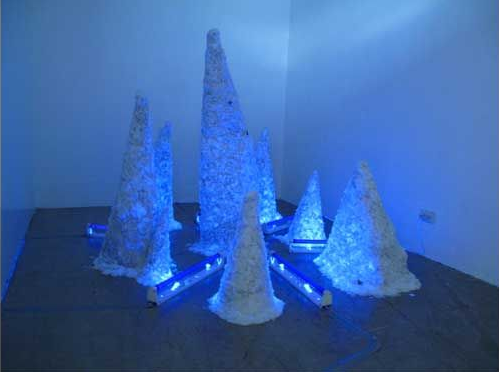Into the Rabbit Hole (2010)
Adeline Ooi: I’d like to talk about you and Yasmin (Sison)’s “Alice and Lucinda” diorama photos that the both of you have created together; in my mind I see that work as a launching point for the work you’ve been making over the past few years somehow–
Lena Cobangbang: – it’s still my favorite “Alice and Lucinda” work –
AO: – Yeah, I love “Alice and Lucinda” too. Do you feel there is a strong connection between that work you made with Yasmin and the subsequent series you’ve created on your own?
LC: Maybe, remotely I mean for the similarity in recreating environments but that is more about inserting our fictional selves in the recreated landscape of history. What I see as really recurring is the approximation of my projects to failed scientific experiments. Well, sort of…
AO: Maybe this is baggage from my own reading, but when I look at the different bodies of work you’ve made, for example: Terrible Landscapes (2005/2006), Making the Pretty Ache and Miniature Man (2008),Overland (2008) and then Foaming at the end (2009) from your show with Maria (Taniguchi), Hangover Square; I am reminded of you and Min and the crazy diorama photos. Do you see where I am coming from? In my head the diorama photos, the food landscapes, the miniature models – all these controlled and created environments either in the form of photographs or 3-dimensional works, chart a particular progression. How you’ve engaged with the environments has shifted somewhat –
LC: – Oh yeah for sure, I’m looking at my new show from the same perspective. I am also asking myself how the new works will relate to my old works while at the same time looking at how it will make a new statement out of these recurring themes, forms and process.
AO: Landscape has figured very strongly in your works. Can you tell me what is it about landscape that interests or inspires you?
LC: Maybe it’s much too clichéd to say that one is inspired by nature or landscape per se, but there is something powerful about the magnificence and grandeur of a landscape painting ?
– especially as something that leaves the viewer in awe, of wide actual wide open spaces, always hinting at the divine and the sublime…maybe it is due to this reason that people have claimed landscape painting as the precursor of abstract painting, especially Caspar David Friedrich’s Monk By The Sea and Turner’s later paintings.
I also see landscape and its relationship with architecture. I think architecture is very much rooted in defining a landscape, whether contoured by construction of edifices or the opposite, flattening of landscapes, abandoning them to the elements where they become “terrain vagues”
? – and this sense of abandonment and desolation is amplified by the amok of wild overgrowth. I see these weird patches everywhere in the city and I think of it as the countryside creeping in sneakily, trying to take over the concrete pavement, or as oddities of failed urban planning, or the symptom of a place’s neurosis.
For some strange reason, weird songs also tend to get stuck in my head like MacArthur Park and its weird lyrics ?
–“a cake melting in the dark” ?
–what the hell is that? I also like the idea of parks and manicured gardens?
AO: ?–And dioramas? Have you always had a thing for dioramas?
LC: Yes! That’s one of the reasons why I would always visit the Ayala Museum when I was a kid. I was really excited to work with Yasmin on the diorama project, Primary Destinations (2001) before they tore down the old Ayala Museum (for the show titled Space Meeting Place curated by Anna Labrador). I also remember these cardboard books of fairytales that had felt puppets and carpet grass and small brass cups instead of image illustrations. I remember I was so eager to enter that world where everything is soft and palpable when I looked at those pictures…
AO: (Laughter) So you’re curious about “the rabbit hole” then?
LC: I think the rabbit hole came a bit later, when I was older, when I was smoking and drinking and have tried some substances. I remember my Dad asking me ?
some time back if I only did art because I liked playing around…
AO: Do you still feel that way? That you are “playing around”?
LC: Maybe…there was definitely a lot of more of “playing around” in the earlier days but I don’t want people to think I’m still goofing off because they won’t take me seriously. Of course I’d like to have fun (with my work) still but I’d also like to make works with some bite.
Actually, I couldn’t help but laugh by myself while doing my work yesterday. I might appear crazy but I just couldn’t help myself. It occurred to me that the objects I was making could pass off as props for a comedic garden of errors.
AO: I want to discuss your multi-tasking life; working as a production designer and an artist. How do you negotiate the two worlds? Do you draw a distinction between the two – i.e. do you consciously put on the production designer hat when working in film and music videos, and replace that with the artist hat when in the studio? How does it affect your work?
LC: Before I was adamant about separating the two, consciously highlighting the difference between my work as a production designer and an artist. Now I’m embracing the trade/ the work more than ever. In production design, I’ve been trained to think fast and work fast. I am also trained to see objects in space and to think in terms of how they would translate as images on film or when they are photographed. Like for my show at Finale (Art File), The Care for Dead Horses, I didn’t think of it strictly as art but also as set design, like a combination of the two.
I think working in production design has had a big influence on how I conceptualize my work, and to consider the space where my work will be placed in, like creating mise-en-scenes…I think more about the form – i.e. how they’re going to look like when it’s in the gallery. So, when I was given this show here at Mo_space, I began to think how my work would sit in this big space. I was already thinking about doing something with carpets as Mawen (Ong) had offered to give me some of their old stock from Bo Concept Store, treating the carpet as some sort of landscape– the plains, the valley– taking off from my crater, valley plateau series where I made miniatures mostly of mountains and volcanoes. I saw the carpet plains as the horizontal offshoot from that series…
AO: And where do these stories usually come from? Your works are potent with narratives –either you provide the audience with the story or we will automatically fill in the blanks ourselves. Do you see that as one of your relationship to the film world or –
LC: Again that comes up, my primary motive before I made my first photographic series (from Video stills actually) Blue Film Love, was to “mend” my frustration of wanting to make films and being guided by Eisenstein’s principle and Barthes reading of his stills in composing them. I asked myself why would I still want to make films when a singular iconic image is all it takes to tell a story or to induce a narrative.
I have to admit I was such an avid film buff during my student days that I’d tailor-made my college classes around the screening schedule of the UP Film Center. I enjoy the feeling of being in the dark, cold theater and being sucked in by the projections on the screen. I wish I could watch more movies that way nowadays.
I know there’s a strong narrative content in my works even if at first they don’t seem to have one, especially when at first I wanted to induce sensation. But it’s all a set-up. For a time, I was so engrossed with looking at pictures by Jeff Wall, Gregory Crewdson and Philip Lorca di Corcia. I was fascinated by the major set up that these pictures required, like big productions for movies almost, and yet the result of all the excessive and tedious preparation and work is an (iconic) still image that we see in books or displayed in museums and galleries.
AO: You mentioned in your email that you were thinking around a few words and phrases while preparing for the show, namely, “horizontal vs. vertical”, “ground”, “fungi/mushroom”, “grass”, “weeds”, “panther/ black/Der Panther“, “stalactites/stalagmites”. Do you feel the outcome still holds a direct relation to the words/phrases? Or have you taken off into another direction altogether?
LC: I had set out with the intention to make a show that will digress in form from ?my previous one – mountains, volcanoes. And the words became the key words or phrases that were floating around in my head when I was formulating ideas for the show. What I’ve managed to come up with in the end are 5 major objects or “scenes”, which are more about falling, landing, over plains:
1) A thousand bars, and a thousand bars or A Thousand Bars, A Thousand Curtains – the title is inspired from Rilke’s Der Panther poem. And the piece consists of a stuffed panther covered in felt shaped grass standing on a felt covered carpet. It’s like I’ve camouflaged an already dark creature with more superfluous hide – grass, a play on vision. Rilke’s poem, at least from my personal reading, was about the weariness of cramped vision, the smallness of one’s world and basing that vision from that smallness; ennui, futility. And the panther’s footfalls can be as hushed, as soft as felt, as velvet.
2) The midget clown struck by aluminum lightning –the associations and meanings here seem obvious – a joke falling flat or killing a joke.
3) The carpet torched with an image of a skinned panther.
4) The plane crash photo – Velveteen Landing, accidents that take place at night, without a noise.
5) The wax stalactite/stalagmites; I wanted to recreate a fantastical environment with this one. They’re supposed to glow once I’ve slathered petroleum jelly over them. I see them as inverses of mountains that goes beyond the plains, goes too deep, inverse plains or landscapes.
To be honest, I don’t have a title yet for each work. Hopefully by the time I’ve installed the works in the gallery, the words would write themselves down.
AO: Often people’s first reaction to your work is that they think it is badly made. I guess in way it is a reflection of the world we live in –the whole Baudrillard simulacra and simulation argument. Everything is about uniformity, mass-produced, “functional facsimile”. Would you say your kind of work, that “failed science project” aesthetics is a form of resistance to this simulacrum?
LC: Do they really have such reactions to my work? (Laughter). I knew it! I always ?
got low grades for Art as I could never turn in neat craft projects at grade school.
But seriously, I build these little environments as an exercise to assert control, because I’m such a control freak. My ambition to be an architect has always driven me to create worlds, environments and scenarios. Yet, I like the idea of exposed seams, tapes, etc. as I treat them as clues for the audience, to show them, in a small way, the process of the making and to make them aware that it’s just a set-up. Also it’s my way of being honest with my process and materials, acknowledging my own limitations. In a way I would’ve wanted them to be perfect but I would also get turned-off at the same time with the idea of perfection, as I feel there’s more empathy and pathos and humor in derelict objects rather than in shiny, polished objects that has a risky tendency of being designer objects. Yasmin had this idea before that shabby objects were more “art”. Maybe that’s also what drives her to make crafty knitted objects, and that has also subconsciously guided the look of what I make.
AO: I am reminded of something else you mentioned in your email, that you felt like you are creating “a wonderland of dark comedies”. Let’s talk about that, your predilection for dark humour, parody, turning things on their head…
LC: I guess it’s built-in already in my personality. I’d smirk rather than laugh, I hate drama, all those histrionics and I found comedy to be more truthful, honest to the point of brutal. Naturally, my viewing preferences would veer towards that. I’m more about making light of the otherwise dark, puncturing drama with belly laughing retrospection.
About Lena Cobangbang
Lena Cobangbang (b. 1976) graduated from the University of the Philippines with a degree in Fine Arts. Her work is broad-ranging, moving across video, installation, and found objects to embroidery, cookery, performance and photography, obsessive-compulsive and at turns celebratory and macabre.
Apart from making art, she writes and works as a production designer. A founder of the artist collective Surrounded by Water, her art practice extends to doing art administration and exhibit organizing, having been a fellow at the 2008 HAO Summit for emerging artists, curators and art managers in Asia, and completing an artist/curator research residency exchange between Green Papaya Art Projects and Pekarna Magdalenske Mreze in Maribor, Slovenia in 2010. Cobangbang has had solo exhibitions in Finale Art File, “Overland” (2008), “Crater Valley Platea” (2009) and “The Care for Dead Horses” (2010) as well as mo_space, “Velvet Landing” (2010) of which this interview was conducted for. Her works have been featured in group shows in Europe, the United States and Southeast Asia.
About the author
Adeline Ooi is a curator and arts writer from Malaysia. She is the recipient of The Nippon Foundation’s Asian Public Intellectual (Junior) Fellowships Grant 2002/2003. Since 2003 Adeline has worked on a number of regional projects with institutions and galleries in Southeast Asia either as curator, writer, project manager and/or consultant, focusing mainly on Indonesian and Filipino contemporary art. She has written essays, reviews and criticisms for private publications and magazines and international exhibition publications. From 2006-2008 she worked as Curator at Valentine Willie Fine Art Gallery in Kuala Lumpur. In 2008 she co-founded RogueArt, an art consultancy group specializing in the creative, strategic and organisational management of art projects, exhibitions, collections and publications across Southeast Asia. She is currently on the Board of Director’s at Silverlens Foundation in Manila (Philippines).



















